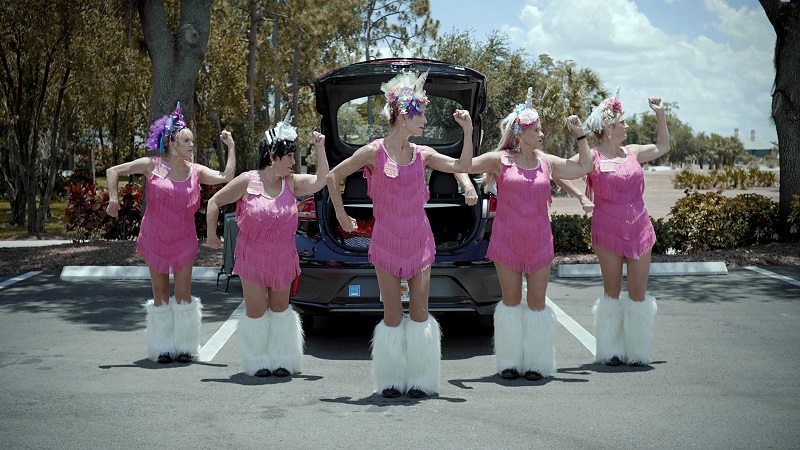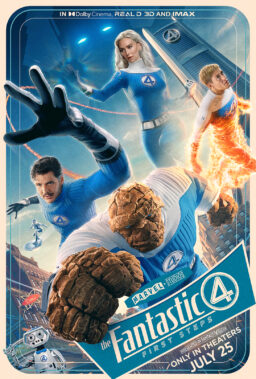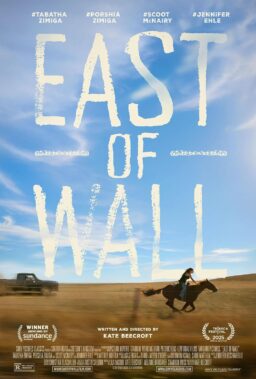In this second dispatch for the World Cinema Documentary Competition, immersive filmmaking takes hold, embedding viewers in dream sequences, virtual realities, and remote jungles. The three selections in this dispatch concern communities: A troupe of over-60 women finding togetherness in dance; during the pandemic, people from across the globe made connections through VR; and a tiny tribe in Brazil is fighting for survival against the bulldozers of “progress.”
Down in South Florida, a group of older women, adorned in pink fringe dresses and glittery unicorn headpieces, spend their days touring the state to raise money to provide service dogs for veterans by dancing. Individually they come from surprising backgrounds: one ebullient performer who served in vice as an undercover Baltimore, Maryland police officer until a degenerative hearing problem forced her to an early retirement. There’s also a DJ, and a Korean war veteran, who found solace in the group after leaving prison.
In “Calendar Girls,” the swift, life-affirming documentary by Swedish co-directors Maria Loohufvud and Love Martinsen, this cadre of talented women, hardworking performers trying to make every day count in their Sisyphean battle against time, take viewers behind the scenes of their exuberant shows.
From the outset, we know this dance troupe is a well-oiled machine. Katherine Shortlidge, the leader of the Calendar Girls, guides them in rigorous practices and plans their performance schedule (usually up to 100 shows) a year in advance. A few of the women hail from gated communities. Others from trailer parks. Some have never danced before.
While the glee they experience dancing provides the initial draw, Loohufvud and Martinsen find rich themes in the ways these women discuss aging. In one frank bar conversation, the dancers discuss assisted suicide, being abandoned by their children, and living in a nursing home. This is also a film about personal freedom defined separately from gender expectations. One dancer wrestles with the responsibilities of being a grandmother, another, the troupe’s talented costume designer, against a dogmatic, controlling husband.
Just as important, however, is the strength and purpose each performer derives from the group. Through stylistic, musical sequences and intimate visual compositions, Loohufvud and Martinsen, vocalize the internal daydreams of each individual woman, as set to an ethereal, whimsical score. Up to its final scene, which recalls “A League of Their Own,” Loohufvud and Martinsen’s heartwarming documentary “Calendar Girls” is an inspirational dance for the young at heart.

At the outset of the Covid-19 pandemic, lockdowns isolated many. If you were lucky, maybe you had a porch or a deck or any old outdoor space that would allow you to, if not plan socially distanced get togethers, at least gather fresh air. Most around the globe were not so lucky. Some turned inward, toward the world of VR to discover the solace and community robbed from them by an unrepentant virus. “We Met in Virtual Reality,” Joe Hunting’s inventive and touching vérité documentary enters the social VR universe to witness the ways the technology has brought comfort, inclusiveness and love in an era of discomfort.
“We Met in Virtual Reality” represents Hunting’s third entry in a series of films that have richly explored the uniquely human connective capabilities present in this kind of technology. For this entry, he filmed through an entire year (2020-21) and parsed through the myriad of unlikely relationships that are made possible in a landscape that allows users to express their inner selves. A pink-haired Jenny teaches ASL through the ‘Helping Hand’ community; two fitness dancers, DustBunny and Toaster, who met each other in VR, are involved in a long-distance relationship as are DragonHeart and IsYourBoi, who found each other in the exotic dance community.
Apart from the different worlds, composed by a colorful array of avatars— hot dogs, space dogs, and so forth—Hunting explicates the ways VR allows a kind of freedom where non-binary, transgender folks and others can be who they are without judgment. Great covers of popular songs like Vance Joy’s “Riptide” provide poignancy. Hunting often uses sound, bleeding early from one scene to the next, to prepare the viewer for the next turn down the VR road.
One of Hunting’s major triumphs is in giving space, relying on a minimal amount of cuts, to allow for his subjects’ experiences to breathe. For instance: A memorial service is held by Ray, an ASL instructor, to commemorate their brother’s death by suicide. It’s so effective, so heart wrenching; every shattered piece lands in the most vulnerable of places. Hunting’s “We Met in Virtual Reality,” is a pure empathy machine, and as real as the people who found each other, amidst a time of great pain, in a little patch of kindness.

Every once in a while, a film comes along that simultaneously elevates your anger and evaporates your hope, while pulling you to believe, against all logic, that maybe, if the right people win, the inevitability of our species’ bleak end can still be blotted out. Alex Pritz’s urgent, visually spellbinding plea, “The Territory,” surveying the fight being waged by invading land grabbers and the tiny Indigenous Uru-Eu-Wau-Wau tribe in Brazil, rises to those heights.
The Uru-Eu-Wau-Wau tribe once lived a simple, isolated existence. In the 1980s, the Brazilian government made contact with them. Since then, the population has decreased from thousands to fewer to 200 people, and their homeland, the Amazon rainforest, is quickly being deforested by farmers and land grabbers looking to illegally seize the land for “improvement.”
“The Territory” (produced by Darren Aronofsky) first follows the farmers. Those emboldened by the election of conservative president Jair Bolsonaro, who believe, in a kind of manifest destiny, that the Uru-Eu-Wau-Wau stand between them and a better life. Pritz then nimbly switches perspectives: He chronicles the protests waged by Environmentalist activist Neidinha, and the role of Bítáte, who at the tender age of 19, newly elected by his tribal elders, harnesses modern technology to try to save his ancient homeland.
Pritz’s background as a cinematographer (“The First Wave” and “When Lambs Become Lions”) colors nearly every inch of “The Territory” (Tangãi Uru-Eu-Wau-Wau worked the camera too). Edenic fluttering butterflies filling the frame recedes to sawdust spilling out from a tree, metaphorically akin to human guts, while a chainsaw ravages it. Close-up of insects, living juxtaposed, unnoticed by apathetic man, ebb into lyrical nightmares of hellish forest fires, settling into scorched earth. The sound work is an absolute wonder and terrifying in its vocalization of nature. How the animals and bugs yip to a fever pitch just before a land grabber set the terrain ablaze would be gorgeous if it weren’t so effective in capturing the abject horror.
Bítáte and his people fight bravely against these invaders. And a burgeoning belief that victory can be had does creep into the film, only to be snuffed out (particularly in Katya Mihailova’s rhythmically arresting score). By the end of “The Territory,” both sumptuous and enraging, Pritz reminds viewers how film can be for remembering and preserving as much for rebellion and art.












